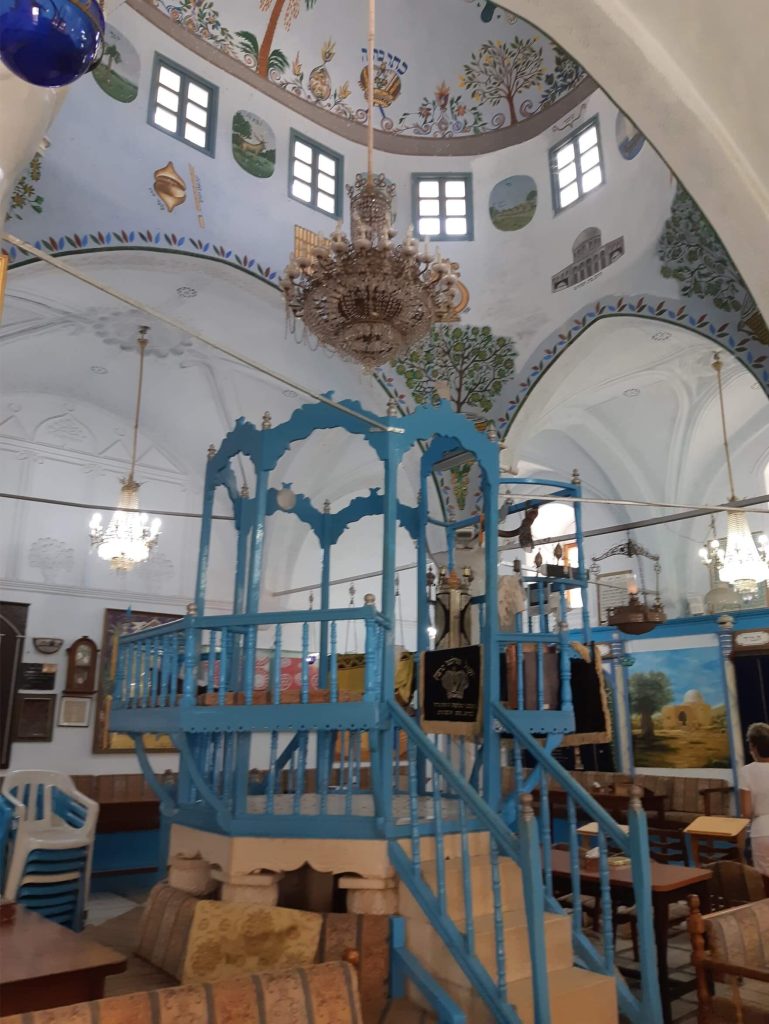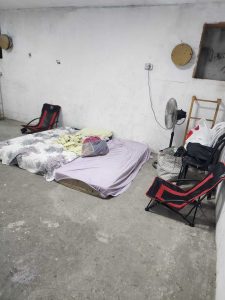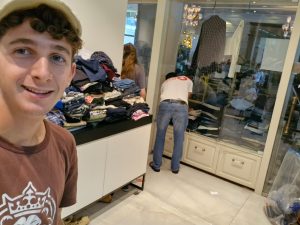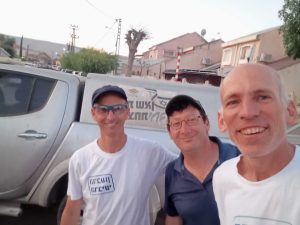I never thought that at the age of eighteen I would be living in a building that shares a wall with a famous synagogue, and their early morning chanting and singing of prayers would be my wake-up call. But it happened, during my gap year between high school and my army service which I spent at a michina, pre army academy in the northern city of Tzfat. I really don’t know how it came to be, but by the time I got acclimated to the situation it felt like I was dropped into a different world.
Once you turn sixteen in Israel you start the draft process into the Israeli army. It begins with a call up for a physical and mental evaluation which result in a profile that will determine which unit the army will assign you to, and if they will offer you pre army tryouts and boot camps for special volunteer units. As motivation to serve was quite high in the circles I grew up in, all through eleventh and twelfth grade this became a dominant subject between our peers.
I also grew up in a modern religious Zionist background, where the value of learning Torah, diving deeper into the knowledge of the religion, and furthering our spiritual connection were encouraged. So, by the beginning of my senior year of high school grade our teachers and Rabbis expected us to defer our enlistment for a program that combines study in a Yeshivah and army service in units made up of religious boys, which allow us to continue our religious observance and growth within the challenging army environment. For many of us serving in the army seemed like the ultimate Zionist action, so the Rabbis sold it to us under the idea that a strong religious identity will strengthen our personality and enhance our service. Yet, many of us didn’t opt for it- we wanted in, and when I say in, I mean all in, in the most elite combat units.
At the same time around the country a new program was formed called Michina. It was created for religious boys, and today has grown to be one of the major options for a gap year around the country. During this one-year period, there is intense religious and Zionist study in addition to physical and motivational preparation for a meaningful army service. New Mechina programs opened around the country, each one more prestigious than the other. Each program prized itself on its high rate of alumni that were drafted to elite combat units and officers it has produced. So, we visited them throughout the year and interviewed hoping to secure a space.
I don’t know why I didn’t follow the herd, as I didn’t find myself in one of the well-known prestigious programs. It could be because I wasn’t all that big, and I wasn’t all that strong and didn’t want to fail the status of special units. Or maybe my soul wasn’t cut out for all the macho military service, even though I did end up with a very meaningful combat service. Or maybe it was because of all the hundreds of times during high school I watched the Pink Floyd movie The Wall, and how I saw how everyone who finished one of these programs were, and I was scared to go through that meat grinder and end up as just Another Brick in the Wall.
On the other hand, it could just be that I chose the off the beaten track program in Tzfat just because when I visited it was still housed in an old hotel, the participants were roaming the building with long hair, musical instruments and the Beit Midrash, study hall, was on the first floor and had the giant letters BAR plastered along its window wall – remnants of a prior use.
Whatever it might have been, come the beginning of the year a small group of 30 boys from across the country gathered in the BAR Beit Midrash in search of a year off, lots of fun and laughter, hiking and jamming, lots of sleep and bumming around. Soul searching was definitely not on the agenda for us.
Tzfat is known as a city where sixteenth century Kabbalah emerged offering Jews a deeper understanding of our consciousness, and our knowledge and awareness of the divine. Sixteenth century Tzfat infused Judaism with new spiritual practices and new experiences of spirituality. As such, in addition to the local religious and Hasidic communities such as Chabbad, Bresslav, Tanzez and others, the city has attracted over time a wide range of soul-searching individuals. Each indivdual has his or her reason for winding up in the city. Some came, others left, and some are still there until today. This group that settled around the old city got to know each other, and over time you felt you were living in another universe.
We traveled together to and from Tzfat on a ‘cheap’ private bus that only those living in the city knew its stations and timetable. It was always overcrowded and some of us would sit or sleep on the aisle floor. Young religious women returning home from a Shabbat at their parents in Jerusalem would board with multiple children, we would say at least seven even though we could never get a straight count, who would cry the whole three-hour drive north. On the steps of the back stairs a young man claiming to be a musician would publicly try out his new songs while playing a guitar that was missing half it’s strings. Some of us would try to get a window seat to lean our heads on and make up for the sleepless night of hanging out with our local home friends who we hadn’t seen for a couple weeks. On Sundays the bus had many regulars, but also always had a newcomer. Those who had just gotten back from a long trip to the east and heard they might be able to extend their trip locally by hanging out in Tzfat. They are very easy to spot. Their baggie and colorful clothing, long hair, backpacks, and bare feet were dead giveaways.
One of the things that traveled fast among the Tzfat Group was the names of individuals that were living in the city, who had extraordinary life stories before their religious turn around, and now teach and share their insights. That is how we came to learn weekly with former Hollywood actor and stuntman Rabbi Daniel Dayan, Kabbalah Artist David Friedman, a Bresslav Hasid who in the past lived on a reserve with Native Americans and practiced traditional leather crafting, Chabbad rabbis, of course Zionist teachers, and followers of the teachings of Rabbi Abraham Isaac Kook, and many more. We had meetings with the Sephardic chief rabbi of Tzfat Rabbi Shmuel Eliyahu, the spiritual leader of the local Breslaw community Rabbi Mordechai Koening, Rabbi Noah Hefetz and others. We were exposed to all walks of the Jewish world, it’s bookshelves and practices. Today I would add all walks of the traditional orthodox world. I was exposed to it all under the teaching of Elu v’elu diveri Elohim Chaim- “these and these are the words of the Living God.” Exposed to it all, without one clear direction. Even though it took me years to find my place, I value my time in Tzfat.
Mid-year we moved into the old city. Into an old complex with a courtyard, known as the Beit Shaki, the Shaki home. This complex is surrounded by synagogues named for great Torah and Kabbalah scholars. On the right side the synagogue named for Rabbi Moshe Alshich, also known as Alshich Hakadosh – the Holy Alshich. On the left side the famous synagogue named for Rabbi Isaac Aboab, which is still in use until today by the Sephardic community, and its interior beautification has made itself a name and attracts visitors from all around the world.
It is here where I find the simplest understanding of Kabbalah. I am a true believer that form follows meaning, and it is within the architecture of our homes and public buildings that we can physically set the stage for what is important for us. For example, if the value of Hachnasat Orchim, welcoming guests to your home, is important to you, your physical space in your home will reflect it. If egalitarianism in the house of prayer is important to a community, the physical interior design of the sanctuary will reflect this. There are many more examples. When entering the Aboab synagogue this concep is clear. Two examples: In the middle of the floor stands the Bima, the raised platform where the Torah is read from every Monday, Thursday, Shabbat, and holidays. It is also the place where the chazen/ shaliach tzibbur leads the prayer. In many synagogues it is raised a step up from the floor level, yet here it stands seven steps up, a significant number in Kabbalah. One can see this as a representation of Mount Sinai, the site where God’s revelation to the children of Israel took place, where they heard the word of God and received the Torah. In a way, every time the Torah is read on the Bima we again hear the word of God, and we are reenacting our standing before God at the foothills of Mount Sinai. This architectural element puts the word of God and his revelation in the center of the community.
Another example is the way the furniture is set up within the interior design of the synagogue, in particular the pews, tables, chairs, and benches used by the members of the congregation. The synagogue is set up by the needs and tradition of the Sephardic community. Different from the Ashkenazi community where the pews are set up in rows facing forward and similar to the lay out of a church, the Sephardic pews are set up with tables and benches on either side around the synagogue. Members of the community sit together facing each other, creating a tight intimacy amongst on another. In this way during the service, members are looking at each other. This style of seating draws our attention to the second element in the center of the community- the community itself.The layout of Aboab Synagogue reflects two of the most essential pieces of this house of worship, the community itself, and its covenant with God in the center.
Another way of understanding the values of a community is the artwork that is chosen to decorate its most important public venues, and once again this applies to our synagogue. In addition to its architectural elements and furniture,the interior of the Aboab Synagogue is decorated with colorful artwork. Paintings of holy sites are hanging on the walls, symbols and verses are embroidered on the three Parochet, curtains, that adorn the three Arks at the front of the synagogue. I would like to draw our focus to the wall paintings that decorate/adorn the inside of the beautiful dome that rises two stories high above the elevated Bima. First, one can see on each one of the four pillars holding up the dome, four vases with flourishing and flowering trees. Above them in a circular fashion, musical instruments are depicted, the ones that were used by the Levites in the Temple as they accompanied the ceremonies in the Temple with song, as mentioned in Psalms 150. Above the instruments is a ring of symbolic pictures representing the twelve tribes and their names. And above those, at the top of the dome is a circle of five crowns. It is the crowns that are most interesting. They are not unique to this synagogue. Many synagogues have crowns, representing the crown of Torah, and many of the Torah Scrolls in a synagogue are adorned with a crown when they are taken out of the Ark to be read before the community. However, here there is one particular crown that sticks out.
In our sources we recognize four crowns in the world. The Crown of Kingship, which we recognize was given to King David and his descendants. The Crown of Priesthood, which was given to Aaron, brother of Moses, and his descendants. The Crown of Torah, which was given to each and every one of us. And above all, the crown of a Good Name, that name you acquire during your lifetime through your deeds. But here, in this synagogue there is another crown, one that is titled Krovah Yeshuve, redemption is near.
One of the simplest understandings of Kabbalah, and most known, is that we live in a broken world. One who practices Kabbalah practices repairing this broken world. This concept is known as Tikkun Olam. Finding the divine in each and every thing we do in the world, and repairing our broken world is the work of bringing redemption. Through this work we will bring closer the Crown of Redemption. But how is this done? Many of us tend to see Kabbalists as people that are very spiritual- living in different spheres. One would say, they are not down to earth, as they are always engaged in elevating themselves and everything around them in the spiritual worlds.
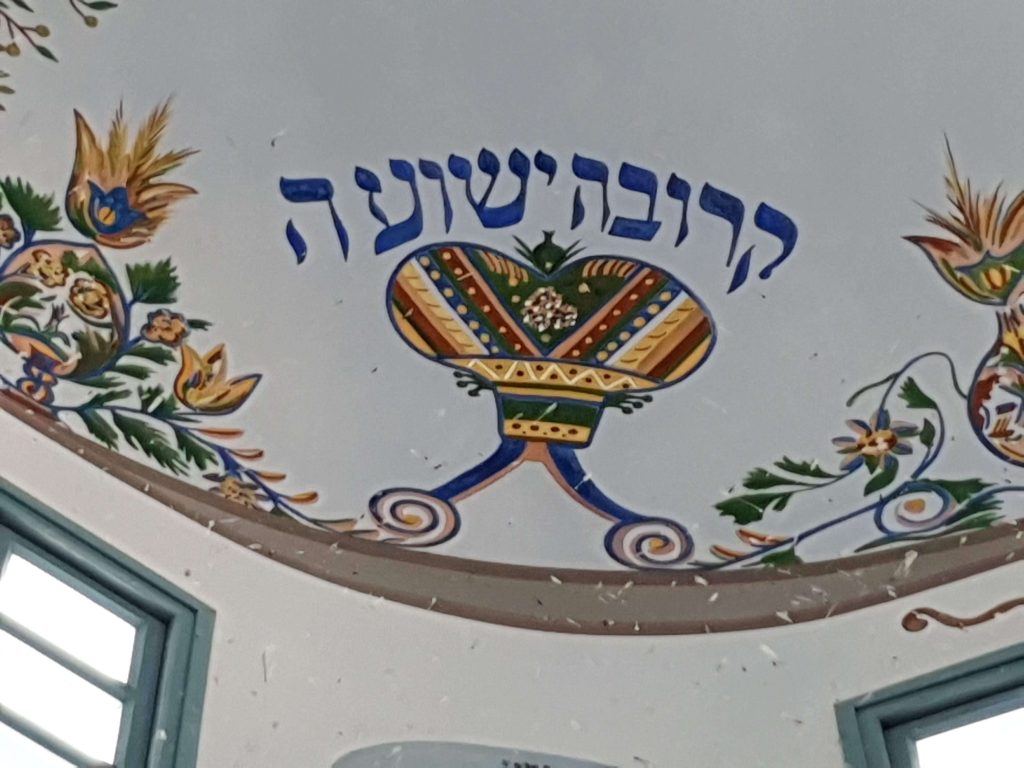
Another unique painting offers us a different perspective. This painting is unique, and I don’t know of other like it in any other place. It is situated in the lower circle in line with the musical instruments on the side facing the front of the synagogue, directly facing the ark. It is also right above the Bima where the leader of prayer stands, and by lifting his eyes a bit he can see it right in front of him. It is small, black and white and depicts the Muslim building that stands on the Temple Mount, known as the Dome of the Rock. Below it in Hebrew it reads Makkom Beit Hamikdash– the site of the temple. This is unique, as most synagogues have a representation of Jerusalem in one of two forms. The first, a picture of the Western Wall, the site below the Temple Mount that has been the most important place for Jewish prayer for hundreds of years. The second, a picture of the reconstruction of the Temple as it was standing in its glory.
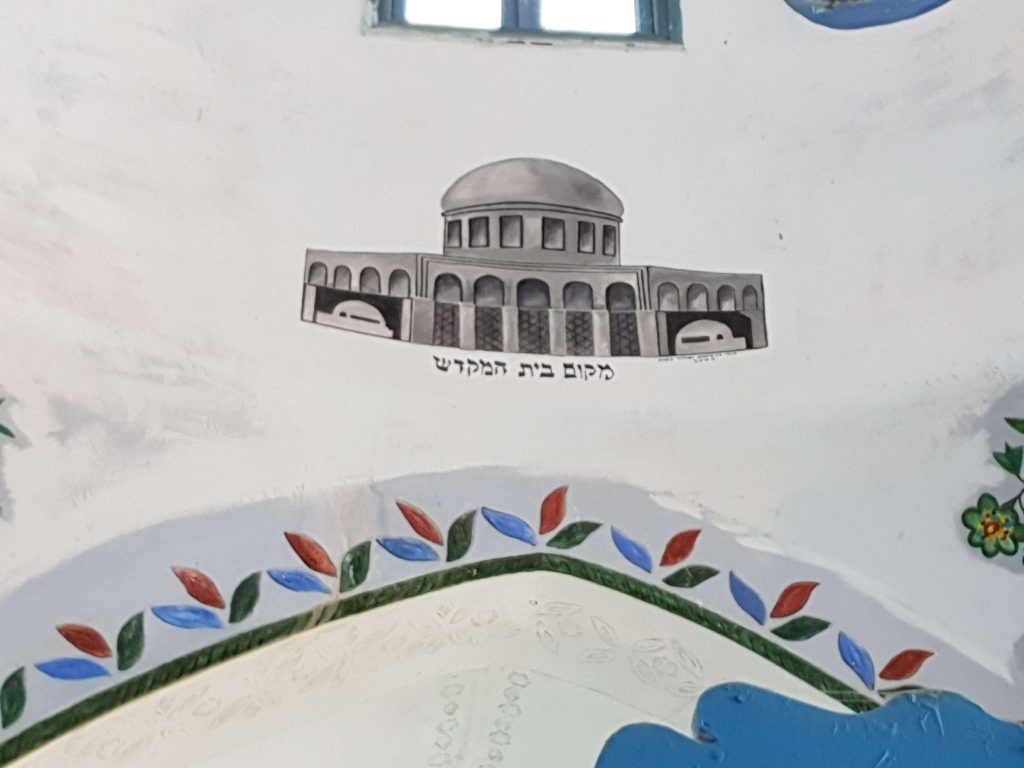
One would suggest that this picture of the Dome of the Rock suggests a realistic perspective of the world. As Kabbalists engage in repairing the world in order to bring us closer to the time of redemption, to the messianic period, one must understand the reality in their world. Here, I understood, to be a Kabbalaist is to look at reality, to see it’s imperfections, it’s needs, and to work towards making the world a better place, in a sense to bring upon the crown of redemptions.
It is in Tzfat, a city I literally fell into at the age of 18, that I find the simplest understanding of the deep teachings of Kabbalah, and all of it is just painted on the dome of a synagogue, right next door.
